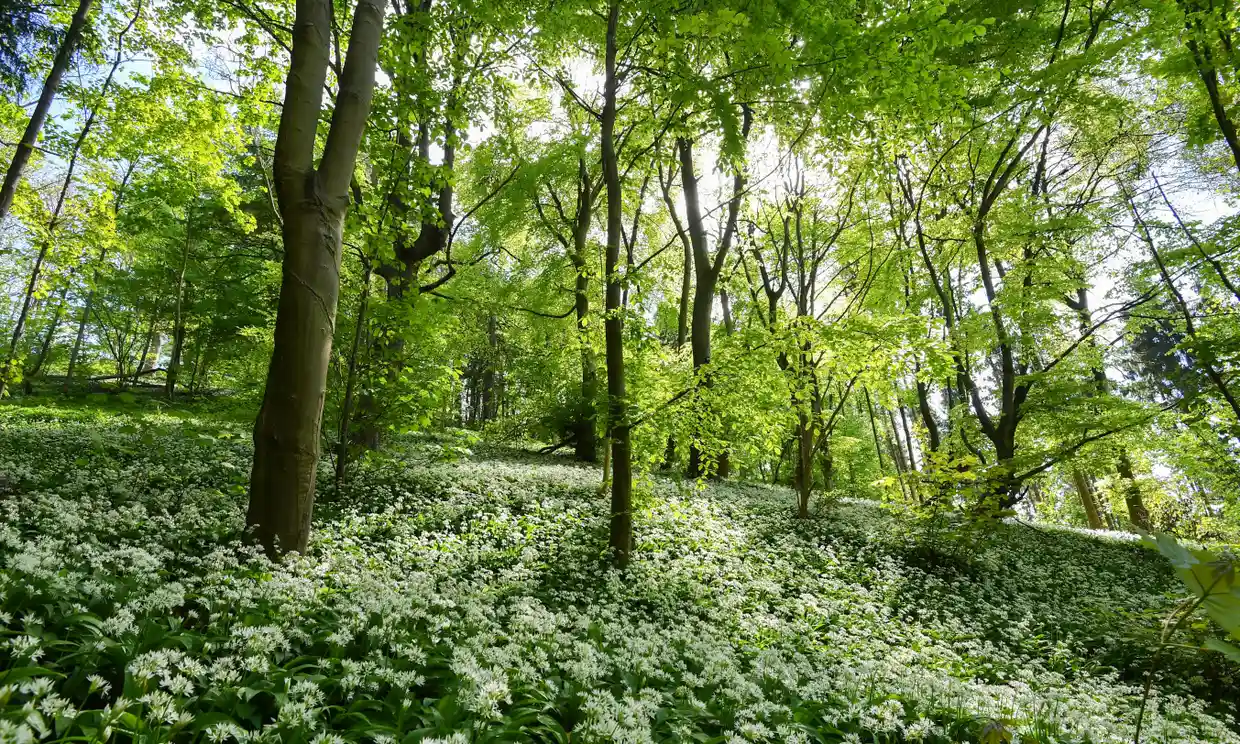Experts say foragers taking too much, selling the goods commercially and harming fragile ecosystems.
Foragers for wild garlic and mushrooms have been picking ingredients in protected sites, taking too much and putting wildlife at risk, experts have warned.
The trend of gathering food in the wild has boomed in recent years, with top restaurants serving foraged food on the menu, and it can be a healthy and sustainable way for people to get closer to nature.
In spring in particular, restaurant menus are full of foraged goods. Jemima Jones, who runs Wild by Tart in Pimlico, London, goes foraging with her children at the weekends on her estate in Somerset.
She said: “That is a fun activity to do with the kids, going into the woods, nettles are everywhere and not that many people use them but they are really nutritious, they are higher in iron than spinach and they are sustainable.”
Jones said: “Right now on the menu we’ve got wild garlic arancini with cheese, a spring salad which at the bottom it has nettle pesto, and we have a martini that is finished on the top with nettle oil, and we have elderflower fritters on the dessert menu. We use an edible flower called lady’s smock, it’s first sort of fruity then it has an amazing wasabi taste. We use borage flowers too.”
Michelin-starred chef Tommy Banks, who runs Roots in York, uses invasive species in his recipes. He said: “The way we forage at Oldstead is absolutely sustainable and strategic. We mainly forage invasive plants or weeds that grow in abundance such as sea buckthorn and Japanese knotweed. We only ever handpick what we need for our restaurants across hundreds of acres. Foraging for these types of species, as well as being delicious, helps allow the ecosystem to thrive once again.”
However, the National Trust has said that people have been picking armfuls of foraged goods in order to sell it commercially, and that it has harmed fragile ecosystems.
Ben McCarthy, head of nature conservation and restoration at the National Trust said: “If undertaken carefully and only for personal use, foraging can be good fun and help people connect with nature. However, excessive foraging, or foraging on protected sites, such as Sites of Special Scientific Interest (SSSIs), can be detrimental to our precious wildlife and negatively impact delicate ecosystems. We want everyone to enjoy the places we care for, but excessive foraging removes nature and beauty from places so others cannot appreciate them. Sadly, we have seen some examples of commercial and unsustainable foraging in recent years.”

The Trust has written a code of conduct for visitors who wish to pick elderflowers, nettles, wild garlic or other ingredients in their gardens and nature reserves, asking them only to pick for personal consumption and to take no more than what they are sure will be used. They suggest only taking one in 20 plants, and warn never to pick protected species, not to forage anything without consent on SSSIs, and to only take ingredients which are obviously abundant and common.
The Wildlife Trusts encourage sustainable foraging as a way to get back to nature.
Rob Stoneman, director of landscape recovery for The Wildlife Trusts, said: “Responsible wild foraging is a great reminder of how nature is bountiful and immensely good for us. Don’t be afraid to get out in the fresh air to gather wild and nutritious food – it’s great for the body but more importantly the soul.
“We must take from the earth responsibly so don’t forage the lot, and leave plenty for wildlife. You must have permission from landowners and know exactly what you’re taking as mistakes can be dangerous. Wild foraging is a great way of honing wildlife identification skills.”
Despite their enthusiasm for foraging, the Trusts have had problems with people taking too much from their reserves, and are suspicious that the foraged goods have been going to the restaurant trade.
Berkshire, Buckinghamshire & Oxfordshire Wildlife Trust (BBOWT) has banned people from picking mushrooms on its nature reserves after reports that groups of foragers had been ripping up fungi on a commercial scale.
Members of the public said they had seen groups walking around Trust reserves in Berkshire such as Snelsmore Common and filling bags with mushrooms. Staff suspected the perpetrators were selling their finds to the restaurant trade.
Roger Stace, BBOWT land manager for Berkshire, says: “We see this problem every year, but I think it’s worsened – we’ve certainly had more reports. I suspect that is partly down to the cost of living crisis, and I fear commercial foragers are selling stolen fungi to restaurants for money.
“We are lucky to have some incredibly rare fungus species on our nature reserves, and if people aren’t trained they could be picking and destroying these rare species.”
Foraging: what’s in season in spring
- Nettles – they are abundant and full of nutrients
- Wild garlic – the trendy ingredient carpets woodlands
- Elderflowers – though they are important for pollinators, so leave more than you take
- Chickweed – an underrated weed full of vitamins and minerals. It is good in salads or turned into pesto
- Dandelions – they are abundant and all parts are edible. Add young leaves to salads, sandwiches or pies. Flowers can be used in risotto or omelettes, for decoration, or to make beer and wine.
- Mallow – its pretty purple flowers are edible and great for decoration. Its leaves are rich in protein, calcium, iron and vitamin C.

